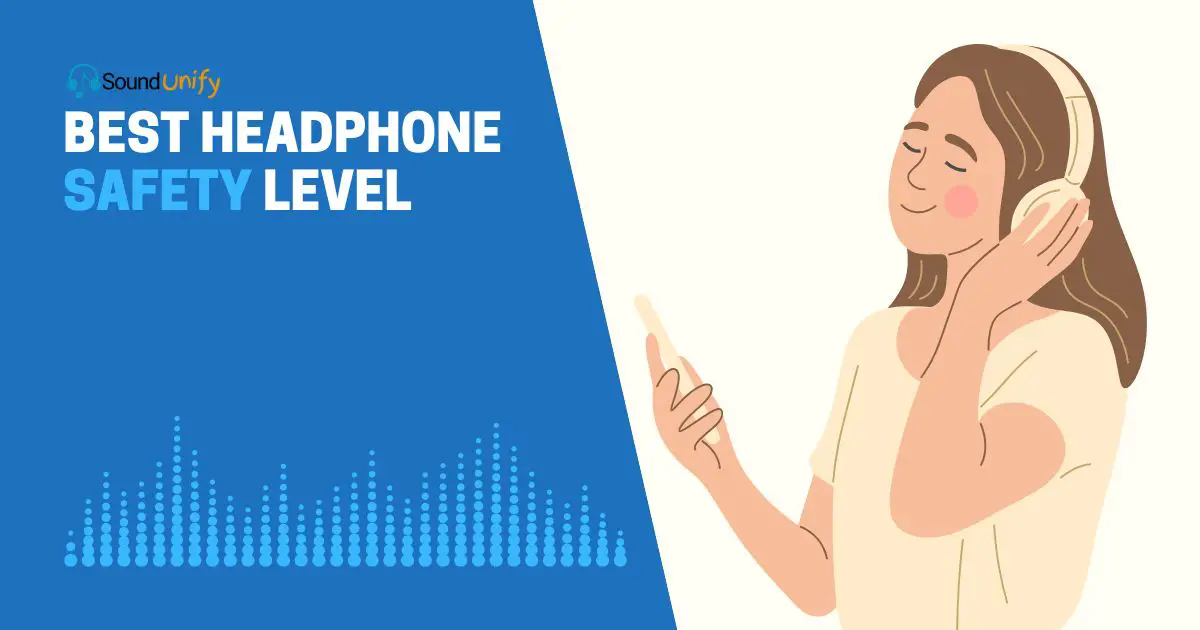The safest level for listening to headphones is at 60% of the maximum volume for no more than 60 minutes daily. This guideline, often called the "60/60 rule," is widely accepted by audiologists.
As a music lover and tech enthusiast, I understand the allure of immersing oneself in a world of sound. But balancing this passion with the need to protect our hearing is crucial.
The issue of headphone safety is more relevant than ever in our tech-saturated world. With the rise of digital devices, we’re constantly plugged in, often without considering the potential harm to our ears.
Excessive volume and prolonged use of headphones can lead to noise-induced hearing loss, a problem that’s becoming alarmingly common.
But don’t worry; I’m here to guide you through the maze of information and help you enjoy your favorite tunes without compromising your hearing health. Let’s dive deeper into the world of headphone safety.
Understanding Sound Levels
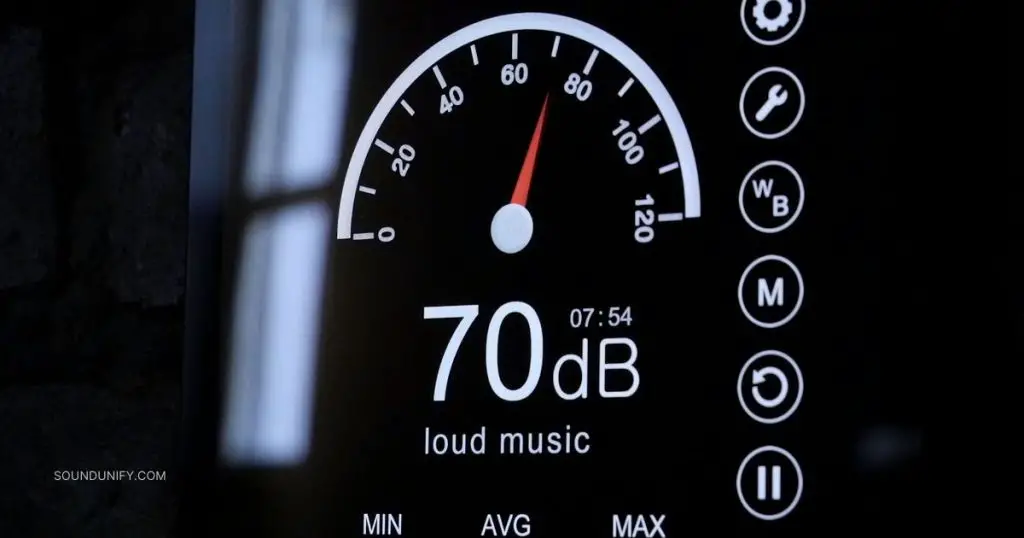
When I first started exploring the world of sound, I was amazed by its complexity. Sound isn’t just something we hear; it’s a fascinating phenomenon involving energy, vibrations, and perception. Let’s dive into the details.
The Science of Sound
Sound, in its most basic form, is energy made by vibrations. Picture this: when you pluck a guitar string, it vibrates. These vibrations cause the surrounding air particles to move. It creates waves of pressure that travel through the air.
This is the essence of sound – a wave of energy moving through a medium (like air or water).
Sound Waves and Vibrations
These waves of energy, known as sound waves, are what our ears pick up and our brains interpret as sound. It’s like when you drop a pebble into a pond.
The pebble creates ripples that spread out across the water’s surface. Similarly, a vibrating object creates sound waves that spread in all directions.
Decibels and Hearing
Let’s talk about decibels (dB), the unit we use to measure sound levels. The quietest sound that the average human ear can hear is 0 dB, a level of near-total silence.
As the decibel level increases, so does the power of the sound. For instance, a sound 10 times more powerful than near total silence is 10 dB.
A sound 100 times more powerful is 20 dB. And a sound 1,000 times more powerful is 30 dB.
To put this into perspective, here’s a table that shows familiar sounds and their decibel levels:
| Sound Source | Decibel Level (dB) |
|---|---|
| Near total silence | 0 dB |
| Whisper | 15-25 dB |
| Normal conversation | 60 dB |
| Vacuum cleaner | 70 dB |
| Lawnmower | 90 dB |
| Rock concert | 120 dB |
Sound Levels and Our Hearing
You might be wondering, “Why should I care about decibels?” Well, our ears are susceptible. Prolonged exposure to high decibel levels can lead to noise-induced hearing loss. That’s why it’s essential to understand sound levels and protect our ears.
For example, listening to music at a rock concert (around 120 dB) for more than a few minutes can cause immediate and permanent hearing damage.
On the other hand, you could listen to a normal conversation (around 60 dB) for hours without risking your hearing health.
The Impact of Loud Sounds on Hearing
When I first learned about the impact of loud sounds on hearing, I was genuinely surprised.
It’s easy to overlook how our daily habits, like listening to loud music or working in a noisy environment, can affect our hearing health. So, let’s delve into the details.
1. Temporary vs. Permanent Hearing Loss
Exposure to loud noise can lead to both temporary and permanent hearing loss. Have you ever noticed that sounds seem muffled or distant after leaving a loud concert or taking off your headphones after a long music session?
That’s a sign of temporary hearing loss, a quick threshold shift. Your hearing usually returns to normal after a few hours or a good night’s sleep.
However, if we repeatedly expose our ears to loud sounds, we risk causing permanent damage. This is because loud noises can damage the hair cells in our inner ear.
These cells convert sound waves into signals that our brains can interpret. Once damaged, these cells cannot regenerate, leading to permanent hearing loss.
2. Tinnitus: A Common Symptom of Overexposure
One common symptom of overexposure to loud sounds is tinnitus. Tinnitus is the perception of noise or ringing in the ears when no external sound is present. It’s a sign that we’ve overworked our ears.
In my experience, I’ve noticed a ringing in my ears after attending loud concerts without using ear protection. It’s a wake-up call, reminding me to care for my hearing better.
3. The Role of Decibels
The risk of hearing damage is directly related to the sound volume, measured in decibels (dB), and the duration of exposure. The louder the sound, the shorter the time it takes for hearing damage to occur.
Here’s a table to give you an idea of safe exposure times for different decibel levels:
| Decibel Level (dB) | Maximum Exposure Time |
|---|---|
| 85 dB (heavy city traffic) | 8 hours |
| 88 dB (food blender) | 4 hours |
| 91 dB (subway) | 2 hours |
| 94 dB (lawnmower) | 1 hour |
| 100 dB (headphones at total volume) | 15 minutes |
| 106 dB (concerts) | Less than 4 minutes |
Remember, these are maximums. Regular exposure to sounds at these levels can still damage hearing over time.
4. Damage to Inner Ear
When we expose our ears to loud sounds, the most vulnerable part is our inner ear, specifically the cochlea. The cochlea is a spiral-shaped organ that converts sound vibrations into electrical signals that our brain can interpret.
Inside the cochlea are tiny hair cells that move with the vibrations and trigger these electrical signals.
However, these hair cells are delicate. Loud sounds can cause these cells to move too much and get damaged. Once damaged, they cannot regenerate, leading to permanent hearing loss.
Here’s a table showing how different parts of the cochlea respond to various frequencies:
| Frequency | Part of Cochlea |
|---|---|
| High frequency (treble) | The base of the cochlea (closest to the middle ear) |
| Mid-frequency | Middle of the Cochlea |
| Low frequency (bass) | The apex of the cochlea (furthest from the middle ear) |
5. Overworked Hair Cells
When we expose our ears to loud sounds:
- The hair cells in our cochlea work overtime to convert these sounds into electrical signals.
- Over time, these cells can become overworked and stressed, leading to damage or death.
- Unlike some cells in our body, hair cells in our cochlea can’t regenerate. Once they’re gone, they’re gone for good.
- This is why giving our ears a break from loud noises is so important. Like the rest of our body, our ears need time to recover.
6. Damage to Auditory Nerve
Loud sounds can also damage the auditory nerve, which carries sound signals from the cochlea to the brain. When this happens:
- The transmission of sound signals can be disrupted, leading to hearing loss.
- In severe cases, damage to the auditory nerve can cause deafness.
- Unfortunately, damage to the auditory nerve is irreversible. This is why protecting our ears from loud sounds is so important.
7. Surprising Sources of Loud Sounds
We often think of loud concerts or machinery as the primary sources of loud sounds, but there are many surprising sources in our everyday life:
- Personal audio devices: Listening to music with headphones at high volume can reach levels up to 105 dB.
- Household appliances: Items like hair dryers, blenders, and vacuum cleaners can produce sounds between 70-90 dB.
- Recreational activities: Activities like motorcycling, hunting, or attending sporting events can expose you to sound levels above 100 dB.
- City traffic: Living in a busy city exposes you to 85 dB or more noise levels.
Remember, it’s not just the loudness of the sound but also the duration of exposure that can cause damage. So, take steps to protect your hearing, like wearing ear protection or taking breaks from loud environments.
How to Measure the Volume Level of Headphones?
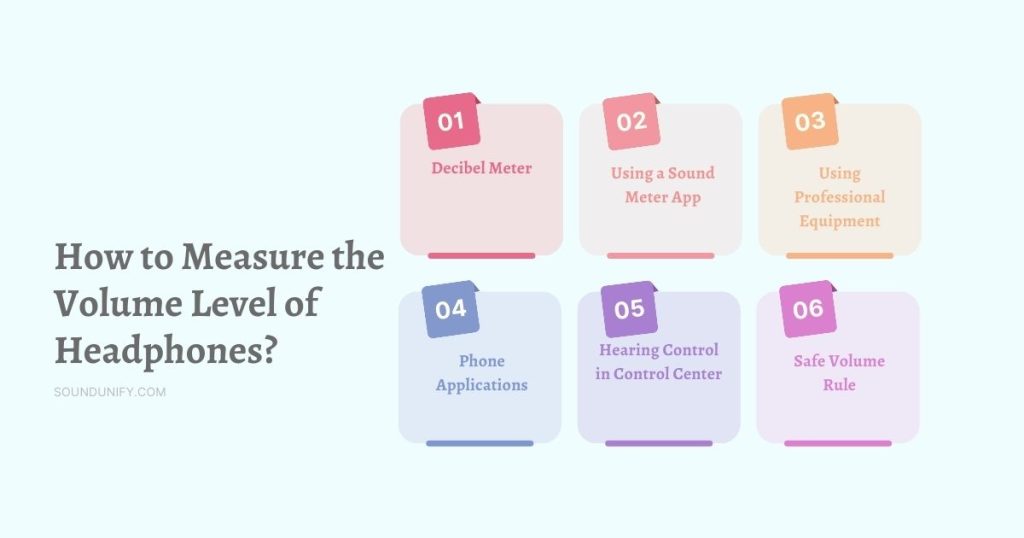
I never thought about the volume level when I first started using headphones. I just turned the dial until I could hear my music.
But as I learned more about the potential damage loud sounds can cause, I realized how important it is to measure headphones’ volume levels.
Here’s how you can do it.
1. Decibel Meter
A decibel meter or a sound level meter is a device used to measure sound levels in decibels. It’s a professional tool often used by sound engineers, health and safety officers, and audiologists.
You can get an accurate sound level reading by placing the meter near your headphones. However, these devices can be expensive and are typically used in professional settings.
2. Using a Sound Meter App
One of the easiest ways to measure the volume level of your headphones is by using a sound meter app. These apps use your smartphone’s built-in microphone to measure the sound level in your environment.
Here’s how you can use a sound meter app to measure your headphone volume:
- Download a sound meter app on your smartphone. Many free options are available on the Apple App Store and Google Play Store.
- Open the app and start playing music through your headphones at your preferred volume.
- Hold the earpiece of your headphones near your phone’s microphone. The app should display the sound level in decibels.
Remember, prolonged exposure to sound levels above 85 dB can cause hearing damage. If your headphones produce sound above this level, consider reducing the volume.
3. Using Professional Equipment
You can use professional equipment like a sound level meter or an artificial ear for a more accurate measurement.
These devices are designed to measure sound levels accurately and are used by audiologists and sound engineers. However, they can be expensive and not practical for everyday use.
4. Phone Applications
In the digital age, our smartphones have come to the rescue. There are numerous apps available that can turn your phone into a makeshift decibel meter.
My favorites include Sound Meter, Decibel X, and NIOSH Sound Level Meter. These apps use your phone’s built-in microphone to measure the sound level. Here’s how you can use them:
- Download one of the apps on your smartphone.
- Open the app and start playing music through your headphones at your usual volume.
- Hold the earpiece of your headphones near your phone’s microphone. The app should display the sound level in decibels.
5. Hearing Control in Control Center
Many smartphones and digital devices have built-in settings to help manage and control the volume level. For instance, iPhones have a feature in the Control Center called “Hearing.”
This feature lets you see a real-time graph of the headphone audio levels, helping you ensure that the volume stays within a safe range.
6. Safe Volume Rule
Following the safe volume rule is essential regardless of how you measure the volume level.
A commonly recommended guideline is the 60/60 rule, which suggests listening to audio at no more than 60% of the maximum volume for no more than 60 minutes at a time.
Following this rule can help protect your ears from potential damage caused by prolonged exposure to loud sounds.
Best Headphone Safety Level
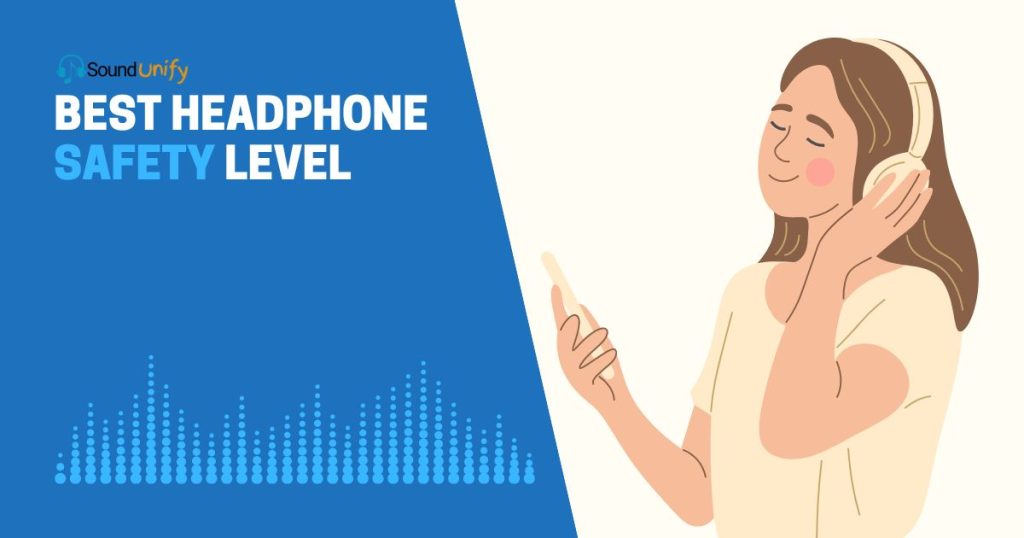
The headphone safety level is crucial, especially in our modern world, where headphones have become a staple in our daily lives. Let’s delve deeper into this subject, drawing from scientific research and expert opinions.
1. Expert’s Recommendation
According to a survey by Lee et al, 16.4% of the participants were found to listen to portable music players (PMPs) at levels that place the listener at risk of noise-induced hearing loss.
This highlights the need for preventive measures to avoid a potential epidemic of noise-induced hearing loss from inappropriate PMP use. Experts recommend keeping the volume safe, typically below 85 decibels (dB).
For reference, a normal conversation is about 60 dB, while a loud concert can reach 120 dB. It’s also essential to take regular breaks to rest your ears.
2. WHO Recommendation
The World Health Organization provides several recommendations for safe headphone use:
- Limit the use of headphones to no more than one hour a day.
- Keep the volume below 60% of the maximum.
- Use noise-canceling headphones to reduce the need for high volume in noisy environments.
- Regularly rest your ears to reduce the risk of damage.
3. Safe Volume Rule
The safe volume rule is a guideline to help protect your hearing when using headphones. The rule suggests that you should:
- Keep the volume at 60% of the maximum.
- Limit headphone use to 60 minutes a day.
This is often referred to as the 60/60 rule.
4. Safe Volume Levels
Safe volume levels for headphone use are typically below 85 dB. Here’s a rough guide to understanding decibel levels:
| Sound Source | Decibel Level (dB) |
|---|---|
| Normal conversation | 60 |
| Motorcycle | 90 |
| Rock concert | 120 |
| Jet engine | 140 |
5. Personal Listening Threshold
The personal listening threshold is the volume level at which you can comfortably hear music through your headphones without straining your ears. This level varies from person to person, but keeping it below 85 dB is generally recommended.
6. Noise-Canceling Headphones
Noise-canceling headphones can help protect your hearing by reducing the need to increase the volume in noisy environments. Here are some benefits:
- They reduce background noise, allowing you to listen at a lower volume.
- They can improve the sound quality, making for a better listening experience.
- They can reduce the strain on your ears, especially in noisy environments like airplanes or busy offices.
Best Headphones for Safe Listening
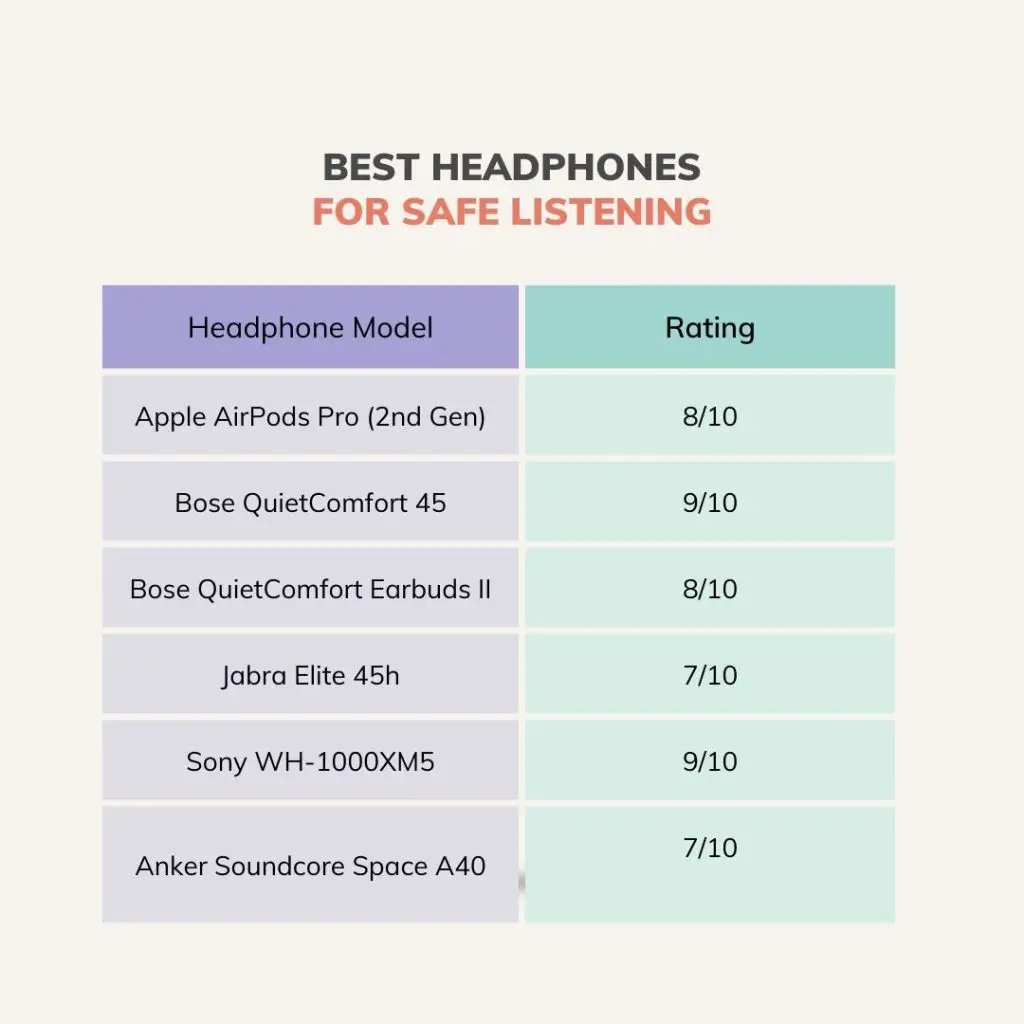
When it comes to safe listening, the quality of your headphones can make a significant difference. Here are some of the best headphones for safe listening:
- Apple AirPods Pro (2nd Generation): Seamless integration with Apple devices, rich audio, excellent active noise cancellation, but lack hi-res codec support, and non-adjustable EQ presets.
- Bose QuietComfort 45: Top-notch noise cancellation, sculpted audio, exceptionally comfortable, but the ANC can’t be adjusted, and the sound signature may not be accurate for audiophiles.
- Bose QuietComfort Earbuds II: Engaging audio performance, fantastic noise cancellation, water-resistant build, but no way to turn off noise cancellation, and the case doesn’t support wireless charging.
- Jabra Elite 45h: Powerful audio performance, adjustable EQ via the app, comfortable on-ear fit, and compatibility with Amazon Alexa and Google Assistant.
- Sony WH-1000XM5: Excellent for Hi-Res Audio, top-notch active noise cancellation, intuitive on-ear controls, and a comfortable, stylish design.
- Anker Soundcore Space A40: Best earphones under $100, rich audio performance, quality active noise cancellation, strong battery life, and a water-resistant build.
Remember, even with these headphones. It's essential to follow safe listening practices. Keep the volume moderate, and take breaks to rest your ears.
FAQs
How loud are 85 decibels on headphones?
85 decibels is quite loud. It’s comparable to the sound pressure level of a milling machine or a snow blower. Prolonged exposure to this level of sound can potentially cause hearing damage.
What are safe decibel levels for humans?
Generally, sounds at or below 70 dB are considered safe for any duration of exposure. Sounds above 85 dB can cause hearing damage if exposed to them for more than 8 hours without protection.
What is the normal dB level for music?
The normal dB level for music can vary widely depending on the genre and the setting. However, a typical conversation is around 60 dB, while a live music concert can range from 100 to 120 dB.
What a safe decibel volume for 6-8 hours a day?
According to the National Institute for Occupational Safety and Health (NIOSH), the recommended sound exposure limit is 85 dB for 8 hours daily. This is because the risk of hearing damage increases as the sound level and duration of exposure increase.
Does anyone take headphone safety really seriously?
Yes, many people take headphone safety seriously. Prolonged exposure to loud sounds can lead to noise-induced hearing loss, so keeping the volume safe and taking regular breaks to rest your ears is essential.
Final Thoughts
While exploring the best headphone safety level, I discovered it’s not just about the decibels. It’s about understanding sound levels, recognizing the impact on our hearing, and choosing the right headphones.
It’s about being aware and making smart choices. Remember, even the best headphones need a responsible listener.
So, let’s turn the volume down a notch, enjoy our favorite tunes, and keep our ears safe. After all, we only get one pair! Happy listening!
James Dimento is a Chief-in-Editor of SoundUnify. He is a headphone enthusiast and creative writer passionate about audio technology. He has three years of experience writing about headphones and sound quality and is responsible for creating reviews and taking care of all administration.
